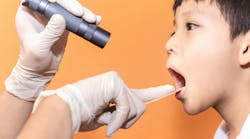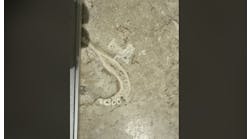When you go for your dental checkup, you expect your provider to look for cavities and gum disease, but what about cancer? Is your dental team checking your head and neck for signs of cancer at each visit?
In 2024, the American Cancer Society estimates that 58,450 Americans will be diagnosed with oral or oropharyngeal cancer.1 That means approximately 160 people will be diagnosed every day. And sadly, every day 33 of those will lose their battle. When these cancers are found in the early stages, patients can have a survival rate of 80%–90%. Unfortunately, the majority are found as late-stage cancers, and these patients have a high death rate of 43% at five years from diagnosis.
What to look for
The first tip to know if your dental team is performing an oral cancer exam is they should tell you! But if they forget to mention it, here are some things to look out for to ensure you are getting a thorough exam.
Initial assessment
As soon as you are called back to the operatory, your clinician should be assessing your health. They are watching how you walk, looking for asymmetries in your whole body that might give them clues to something more serious going on.
Once you are seated and your medical history is updated, your clinician will continue the exam. They might start by looking at your face, noting any asymmetries or visual lumps or bumps. They will pay close attention to your nose, ears, scalp, and hairline. They might even lift up your hair to check for any signs on the back of your neck.
Extraoral exam
Then, they might begin the extraoral part of the exam by palpating your face. They will lightly press on your cheeks, salivary glands, under the chin, the thyroid, lips, and jaw joint to feel for any abnormalities. Perhaps they’ll ask you to open and close and swallow to ensure that everything looks normal. They’ll have you turn right and left while they feel the long muscles in your neck. These are all places that could give them clues to underlying issues.
Intraoral exam
After checking your head and neck, it’s time to move inside your mouth. Once again, they will palpate your lips, the inside of your cheeks, the floor of your mouth, tongue, and palate. You might even feel like Elastigirl as they stretch your lips, tongue, and cheeks to get a better view. It’s key to get a good view of the back of the throat, so you get to unleash your best aah! as they press on your tongue to view your tonsils, uvula, and airway.
Questions
While all this is happening, your clinician might be asking you questions such as:
- Have you had any difficulty swallowing?
- Does it feel like you have something caught in your throat?
- Have you experienced any persistent hoarseness, change in voice, or cough?
- Do you have any pain in your ear, jaw, or mouth?
Symptoms like these could be signs that something is going on deeper in the throat that might not be apparent in a visual exam.
What if you get a referral?
If your dental team sees anything suspicious and it persists for two weeks, they will most likely refer you to a specialist for further evaluation. If this happens, be sure to follow through. This does not mean that you have oral cancer, but there’s something there that needs to be looked at and soon. Susan Cotten, BSDH, RDH, OMT, owner of Oral Cancer Consulting, says, “If it’s not right, it’s wrong. React and refer!” Remember that when caught early, oral cancers are very treatable.
Reference
- Key statistics for oral cavity and oropharyngeal cancers. American Cancer Society. Updated January 19, 2024. https://www.cancer.org/cancer/types/oral-cavity-and-oropharyngeal-cancer/about/key-statistics.html
Amanda Hill, BSDH, RDH, CDIPC, is an enthusiastic speaker, innovative consultant, and award-winning author who brings over 25 years of clinical dental hygiene and education to dentistry. Recipient of OSAP’s Emerging Infection Control Leader award and an active participant with the advisory board for RDH magazine, DentistryIQ, and OSAP’s Infection Control in Practice Editorial Review Board and membership committee, Amanda (also known as the Waterline Warrior) strives to make topics in dentistry accurate, accessible, and fun. She can be reached at [email protected].






